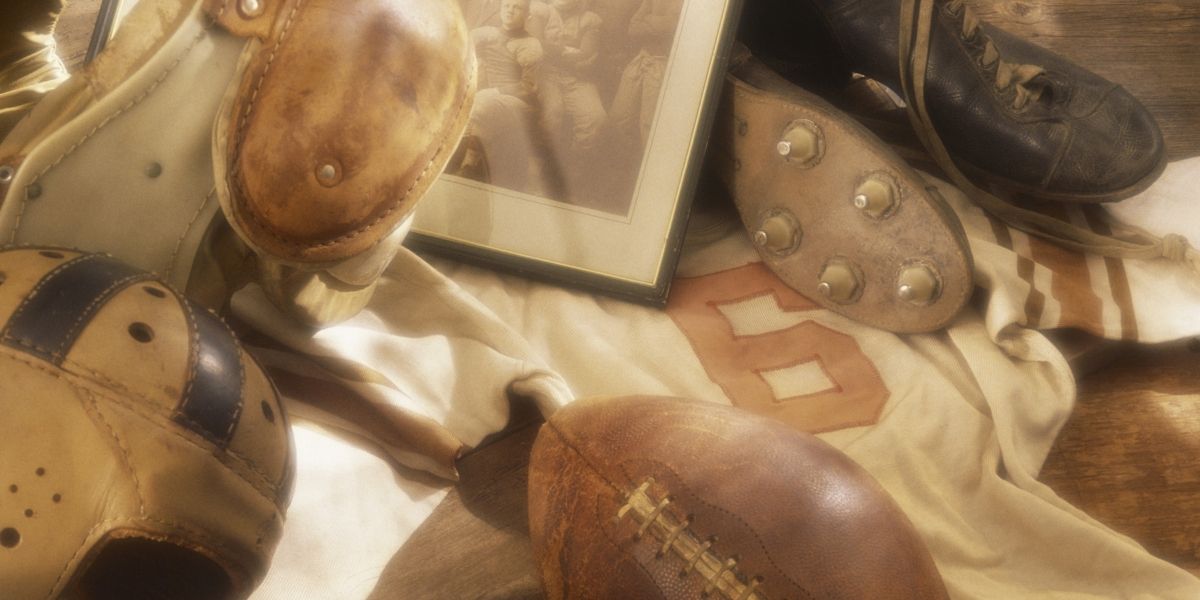Game Changers: The Transformation of Football Gear Through the Ages

Since its inception in the late 1860s, football has changed to become the game that it is today. Structures have evolved. Keeping score has evolved. The rules have evolved. Groups have evolved. Naturally, players have evolved as well.
However, in thinking back on the game's history, we might not consider how the gear used by players has changed over time. Most of the equipment used now is portable, strong, and protective. So, in what ways has this evolved over the last few decades?
Helmets
Among all the equipment used by football players, helmets are arguably the most important. They act as a shield to keep your head safe from forceful blows and potentially fatal head injuries.
Football players first wore helmets in the 1920s. Manufacturers used leather with a bit of padding inside to make them. These handcrafted helmets offered very little protection and lacked any kind of facemask. In 1939, the first plastic helmet became available. But the NFL didn't formally introduce plastic helmets for ten years.
A facemask, chinstrap, and a rigid plastic shell with enough cushioning within are the materials that make football helmets today. In terms of lowering the total number of concussions, the design has proven to be successful.
Cleats
The earliest football cleats were actually created for baseball, not football. However, there was a ban on metal baseball cleats in 1873. Wood and leather spikes took their place.
In the 1920s, rubber cleats which you could switch out became available. Football stakeholders introduced regulations that required extra wide football cleats to stop skin and garment penetration. Manufacturers were using metal for cleats once more.
Sports footwear underwent major alterations when the game was on artificial grass decades later. Several tiny "cleats" on a single piece of molded sole comprised the entire sole in place of the customary "spikes." These days, manufacturers use lightweight synthetic materials to make shoes that have smaller cleats.
Shoulder pads
The late 1980s saw the invention of the first shoulder padding. Players made them themselves using cushions and a cord. The use of shoulder padding increased around the turn of the century. Manufacturers started producing shoulder pads made of leather that they sew into your jersey.
Manufacturers later adopted shoulder padding for harnesses in the 1940s. This pad seemed like the same kind that we use in football nowadays. You’d get them stitched to the chest and positioned above your head.
Synthetic pads brought about yet another breakthrough development forty years later. For players, the synthetic material truly saved our lives. Compared to the materials previously utilized, it was stronger and lighter.
Jerseys
Originally, football jerseys were just plain pullover shirts made of wool or cotton. Later, in the 1970s and 80s, they added sweaters and jackets made of canvas and moleskin.
In the early 1900s, wool pullover jerseys became the norm. To help secure the football, many teams utilized grip-sure materials. Wool pullovers were out of style in the late 1930s, after being in style for almost forty years. In the 1940s, manufacturers made the first jerseys from synthetic fabrics. Afterward, some athletes began donning fabrics that were "tear-away."
The look and feel of jerseys have evolved through time to resemble mesh, which helps to wick away perspiration and keep you cool. Additionally, they've gotten increasingly form-fitting. Holding becomes less likely and tackles more challenging as a result.
Pants
Of all the equipment, pants are most likely the one that has changed the least through time. In the 1880s, football trousers with padding became available. However, manufacturers made the pants from canvas, with the padding sewn into the knee and thigh areas.
The end of the century saw the addition of hip cushioning. The materials used to make football trousers have undergone significant changes since then. Pants evolved from materials like wool and canvas, much like other football gear. Nowadays, manufacturers use more practical and synthetic materials like rubber and nylon.
Balls
A spherical rubber ball served as the original football. When soccer regulations gave way to rugby rules, manufacturers made a new ball from leather with a rubber bladder. The ball becomes increasingly streamlined over time to aid in passing.
Not much has changed in the ball's shape since 1934. Naturally, manufacturers may use many artificial materials and equipment to produce footballs in large quantities. However, not much has changed in terms of general shape, feel, or design since the early to mid-1900s.
Conclusion
Football, an ever-evolving sport, has seen remarkable changes not only in its rules and play but significantly in its gear over the decades. From rudimentary leather helmets to advanced protective headgear, and from simple wool shirts to sweat-wicking mesh jerseys, the transformation signifies the sport's dedication to player safety and the march of technological advancements. The evolution of football equipment chronicles a journey from humble beginnings, relying on available materials, to today's high-tech, purpose-engineered gear, reflecting the sport's growth and the continuous drive to enhance player experience and safety on the field. It's fascinating to think about where the next generation of innovation will take this beloved game.